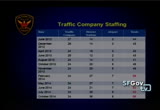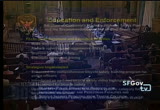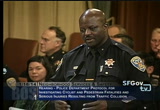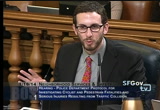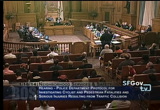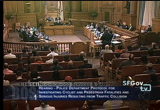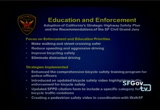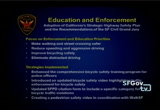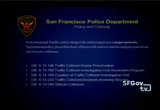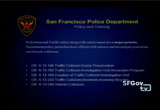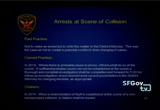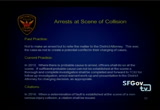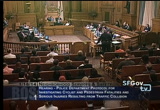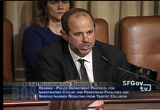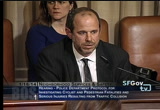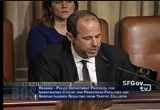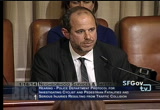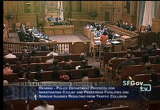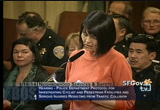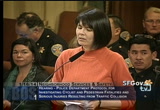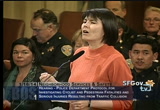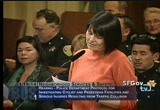tv [untitled] January 17, 2014 8:00am-8:31am PST
8:00 am
officers assigned to the various district stations and they're used in conjunction with the district station captains overall strategy in doing. the numbers in red in terms of total reflect projected hiring as well. we're currently at 24 at the hall of justice. 24 at the district stations and four at the airport. so but we're right in the ball park of projected numbers. >> supervisor kim, did you have a question. supervisor wiener. >> thank you mr. chairman. i have a question about the break down of the citations. i know on one of your slides, it's broken
8:01 am
down by police precinct. >> yes. >> how does the department or does the department track how more precisely where the citations are being issued in terms of on specific blocks or specific intersections knowing more specifically of a police district where the citations and dangerous driving is happening. >> absolutely. as i indicated, we embarked on a collision data base. that data base has a component for traffic citations and with the traffic company, those officers have been given technology that allows for them to write electronic citations. so the information is captured electronically and allows for the analysis that you're talking about. in regards to being able to -- if you will --
8:02 am
geo map of this enforcement, the technology is in place and we're in the phase of fully realizing that capability and i anticipate by some time by the end of april at the latest, we'll be able to report out on where our traffic motorcycle officers are conduct the enforcement and it will be reflected on overall enforcement efforts. >> to be clear, one this is fully operational, will every citation, 100 percent of the citations be in there or some officers will be handwriting. >> some officers will still be handwriting citations? >> why is that. >> the devices are expensive. we don't want to have duplication. we're hoping that as we see
8:03 am
improvement in technology, we'll realize the capacities of smartphones. i they we're on the verge of see -- i think we're on the verge of seeing our cities and other cities issue citations by way of smartphones. the desire is out there in the technology field, but it hasn't come to light yet. >> in terms of them being able to map where the citations are being issued, it seems that it won't be -- it will not be altered but be the sub selt of the officers using the electronic devices. >> that's correct. it's about 20 percent of our overall citations are issued by the motorcycle officers. in terms of it being the best gage and best picture, that's numbers that we have to work with. >> if i could interrupt
8:04 am
quickly. >> yeah. >> so the number one priority for director merit of our it section is to try and develop the ability to give the -- it issue the smartphone using a ticket, using the smartphone that we now have in the hands of the officers with the printer and the card that works off the devices that the officers have that is more cost effective. >> in terms of getting the global data, to have a map showing, this is where tickets are being issued, it sounds like that only is a sub set right now. when do you anticipate that we'll get that global? it seems pretty important to know first of all, which are the most dangerous areas, but also on
8:05 am
the flip side knowing people in the community might know this is a horrible intersection for people running lights and there aren't tickets being written here, so it would be helpful for the department to track its own scope. >> fortunately most of the worse intersection for lights have red light cameras and if you look at that graph on red light cameras and the reason they're going down because the people in the city have learned behaviors and they know are the red light cameras. >> that was an example. it could be running a stop sign or a light. >> the answer to your when is hopefully by the end of 2014. director giffin will have the ability to write a ticket on a smartphone and print it from there. >> colleagues if i may interject, there's a lot of information here and that we have a number of followup questions but i want to focus on clarifying questioning right now so we can complete the presentation and hear from the
8:06 am
public. but i do think that there's a very important point that i want to have clarified and i think it's probably best if i ask chief sir because i think it's a very significant thing that's in the presentation on the page that has -- that says "traffic" there's a mention of zero. supervisor kim has put it forward, so does that mean that the police department is adopting vision zero. i want to get -- >> it's our goal that there be zero fatalities in san francisco. >> that's great. thank you very much. >> thank you. >> do you have a clarifying question as well commissioner chan. >> commander, you can proceed. >> sorry i didn't hit that nail harder >> that's exciting.
8:07 am
>> absolutely. vision zero. back to our slide in terms of education and enforcement, the california safety highway safety plan is a driver force in our overall education enforcement effort as well as the san francisco civil grand jury. the focus on enforcement and education priority are simple. making walking and street crossing safer in our city. we will continue to force you on vehicles that are violating the pedestrian right away and we'll focus on the vehicles that are speeding where pedestrian crosswalk are. improve bicycle safety in the same fashion by focusing on those cars that are aggressive that do not provide
8:08 am
the at quit space for bicyclist sharing the roadway with them and which i think is a huge problem as well that hasn't been measured in very quantity ways. typically, you know, cell phone use, electron i can devices and so forth. the strategy is to be implemented are enhance the comprehensive bicycle training program for our police officers. as you see there are a number of officers who ride bicycles on on daily basis to the tune of 300 officers have been trained and bicycle training and bicycle operation for law enforcement officers. introducing, i should say reintroducing an updated bicycle safety video. as the
8:09 am
chief pointed out, that's currently in play with with -- at all the district stations during the line up where the officers get to see the video that highlights issues like doering and safety zones. this was a video that was done collaboratively in 2007 with the ssf bicycle coalition. we're proud to reintroduce that and update it with a series of videos that address behaviors that we want to focus attention on. one of the recommendations for the civil grand jury was to update the sfpd citation form with a specific category for bicyclist. that has taken place. and we're currently in the mix of creating -- not only an updated bicycle video but a pedestrian safety video in collaboration with
8:10 am
walk sff. a significant aspect of our day-to-day investigation enforcement hinges upon our providing our officers with the best direction -- the best training and so forth. the next slide relative to policy and training speaks to updates and in training and policy. the first one -- at the traffic scene preservation speaks to and directs officers to treat traffic collisions scenes as you would a crime scene. that means the preservation evidence and that means canvassing the neighborhood for video and for evidence. i apologize for the miss step that took place at 6th and fulsom. we
8:11 am
didn't get a video when we should have. had we gotten that video, it would have lessened the negative impact that we obviously caused, but at the same time i want to let folks know when we realized the error, we fixed it and went out and got the video. we conducted a theory investigation. that investigation involved a work up for the warrant for the driver would was responsible for that incident and we're awaiting a decision from the district attorney office in that regard as well. we have created an association program for the traffic investigation unit. there's a tremendous amount of science that goes in investigating these collisions and we have a small group of officers and in patrol that number is growing daily. when i say small, it's in reference
8:12 am
to the amount of training and expertise that needs to be demonstrated in order to be apart of this program. the officers have to have a minimum of approximately 180 hours of training. that means basic training investigation and lastly advanced collision investigation. all of these are post certified courses and every single member of our associate program currently is at the level of advance for hire. we created in 2013 the traffic collision investigation unit by combining the hit and run detail as well as the major accident investigation team. that will be the only time you hear me say accident simply in reference to that name. our policy in dealing with traffic collisions as you
8:13 am
can see 13-2-40 addresses that in terms of making it very clear that the unintended coming to together of vehicles and persons and bicycle on our roadways aren't accidents. they're preventable, they're preventable and preventable. we want everyone to necessity that so we're not using the term accident -- correction, i have to say it again only because of reference. but moving forward, it's all about identifying as collisions so people take responsibility and not look at them as acts of god that are beyond their control. we also addressed -- we reiterated a policy in training that we've had in effect for many years now directing officers that when a bicyclist is in involved in a collision, it could be a single bicyclist who loses balance, hits a pothole, whatever the case may be, that
8:14 am
warrants the creation of a collision report and treating that person in the same fashion that we do all other persons involved in them. this is something that captains are eagerly awaiting, it has been our practice to not make arrest at the traffic scene crime. it is on behalf of the district attorney office, and they ask that we do not create a conflict in the charging decisions by making an arrest at the scene. in 2013 our current practice came to fusion where we have directed our officers that where there is probably cause, there is probably cause, the officer shall make an arrest at the scene if there's sufficient probably cause. this is a matter of
8:15 am
public safety and public education. there's a need for immediate action in these incidents. we then followup with our traffic collision investigation unit in terms of followup investigation and prepare arrest warrants and presentations at the attorney's office when there isn't probably cause. every single collision where there's a loss of life and are serious injury, those cases are presented to the district attorney's office. moving forward in 2013, and i have to thank the bicycle coalition and walk sff for working with us on this. we're implementing a policy that when a determination of fault is accomplished at the scene of a non serious injury traffic collision, a citation shall be issued. and that is in every single traffic
8:16 am
collision where there's an injury that doesn't rise to the level of potentially being presented to the district attorney's office for criminal charges, a citation for the infraction when there is a determination of fault shall be issued. we shall see a traffic department bulletin within a week's time issued to that affect. i like to bring up ed riskin of the mta to make a presentation. i understand we're going to reserve questions for last. >> thank you. >> sure. >> thank you commander. >> director riskin. >> thank you, mr. chair, mr. president. ed riskin, director of transportation for the san francisco mta. i don't have a
8:17 am
presentation to provide, but i want to thank for convening this hearing and thank the respected bodies for their leadership. i guess what i would say as your tran pour tags director, we shouldn't have people dying in our streets trying to make their way around the city. we shouldn't have people seriously injured in our streets just trying to get to where they're going in san francisco. i think there has been a lot of progress made. i think there's been a lot of leadership, but the numbers are still too high. every one of these incidents is tragic. every one of these incidents is unnecessary, so we need to work together as an agency, as a city family, as a city and community to do better. starting with my board of directors, when they two years ago adopted a strategic plan governing the next six years, they identified
8:18 am
safety as the number one priority for the sffmta and anything we do for the transportation safety has to be the number one goal and it has been that -- continues to be that for our agency. the issue to executive director mayor lee followed by convening the pedestrian safety task force and we cochaired with the mayor, that has moved into the walk first program that working with all of our city partners, particularly department of public health, the police department and public works and the planning department to develop a very targeted capital improvement program that will enable us to achieve the goal in that executive directive. to the point of
8:19 am
funding that supervisor mar raised, i think funding is a component of what we need in order to be successful. i think the mayor and the board of supervisors, took an important first step by restoring the police academy and the enforcement as we've heard is a matter of budget and restoring the strength of the traffic company and the department all over, i think is an important part of enforcement with regard to funding the pedestrian strategy, the mayor last year convened transportation task force that developed a set of recommendations for new local funds that included more than $140 million specifically to fund the pedestrian strategy and recommended ballot measures in 2014 and again it 2016 and 2024. so there is some
8:20 am
direction from that -- the results from that process that would infuse significantly more funds into the engineering improvements, the right away improvements that we have a very good sense based on the data we have been able to collect and what would be affected in bringing down the numbers of fatalities and serious collisions. with regard enforcement, we work closely with the police department, with the commander who is assigned to the sffmta. we've worked with them in developing the cross road system at the commander reference which is providing better data for our engineers so we can identify the improvements we need to make in the right away. we've introduced the collision report that serves much of the data that you saw on the presentation. we've developed maps for each of the district
8:21 am
stations identifying where the collisions are so help them focus their efforts, worked with them to get the hand held units as the stop gap as they develop their electronic solution. as the commander said, we'll have close to real time info on more than 20 percent of the citations issued and all the collisions so we'll have much more better data to base analysis that can help the police department most efficiently deploy their resources. and i guess we meet regularly with the police department and share that information back and forth so that the resources can be deployed and now that the resources are starting to come up, i think we'll see much more in terms of enforcement and finally with regard to education, we've been working particularly with the department of public health, but with the police department on developing
8:22 am
an outreach campaign seeking grant funding for that. we should execute a contract for that campaign, i believe this month or early next month. we're working together to seek additional grant funding, such as from the office of traffic safety so that we can get that and the education there and the mayor announced yesterday a step forward in that campaign while the engineering changes are absolutely essential and we can identify the reduction in incidents of collisions that will come from them. they do take time to implement and the mayor felt strongly. we needed something much more immediate and the awareness campaign to really get the message out as the chief relaid that everybody needs to pay attention and everybody needs to slow down, so we're working on a number of fronts, engineering
8:23 am
education enforcement to try and address this issue. i'll close again by saying that people shouldn't be dying in our streets or getting seriously hurt in our streets and i think if we all work together as a city family and with our great community partners we can achieve these goals. thank you. >> thank you, director. commander. >> yes, i'd like it bring up natalie who is the director of membership for walk sff for a presentation for us as well. >> thank you, and thank you to walk sff for their incredible work in this very important issue. >> mrs. verda. >> thank you supervisors, police commissioners for holding and
8:24 am
attendinging this meeting. i want you to end the carnage on this streets. i want to pause and make you think about 25 members that died. had we have a loved one that dies, we know how impactful it is. we have get a lot of data and we get a lot of information, and it's a lot to digest. i want to remind everyone why we're here, to put an end to that. only 20 percent of the trips made in san francisco are on foot. i would love it to be more, but it's only 20 percent currently. yet over 50 percent of the traffic related deaths are pedestrian. that's an injustice. in 2012, nearly 950 collisions were reported. we know for a fact that collisions are actually under reported. so that means every
8:25 am
single day cars hit three people that are walking. and the truth is the playing field between a driver and a human being, a walker, someone bicycling is grossly unequal. when you add to that, environmental conditions in the city such as poor street design, previously a lack of effective enforcement for dangerously driving behavior and violence from traffic crimes. you realize just how dangerous and unjust our streets have become. one in five hospital trauma cases are related to traffic injuries and in fact if you look at violent
8:26 am
crime in the city including stabbings and shootings, two times more violent crime comes from traffic collisions than from those forms of violence. so rather those traffic crimes end in a death like the 6 year old, sofia lew or the 17 year old han chang or brian or 46 year old donald, a resident in the tenderloin or a community leader like elizabeth, whether they end in death or serious injuries like those suffered by monique that some of you may have met or heard of, how stephens who is here tonight whose video i hope to play for you. these crimes cost the city millions
8:27 am
annually. and in unsquad -- we've been talking and talking about this and i feel like i've heard amazing things from commander ali, and i want to thank you personally. we've worked on him on an ongoing basis and three of the things he talked about, i'm hopeful about, with you we've heard pedestrian strategy before and task force before, we need to see things come true. three things to be promising, stop calling them accidents. words are empowering. we should prevent them. the second thing that's encouraging is that they'll be citations so that we treat these things as the crimes they are. so someone knows when they make a decision to speed, they can't mruf it off and go, i don't
8:28 am
have to worry about it. and the third thing is that there is a focus to really use data to drive decisions in the department and hopefully that reporting will go on a regular consistent and a transparent basis. so to sum up before i show the video, i want to urge the city to follow the police department's leadership and example as they're committing to adopting a vision zero. if the police department can do that for enforcement, then mta should be able to do that for engineering and the entire city family should get behind it and fund and get a pedestrian funding and put an end to all traffic deaths. that means drivers, bicyclists, as well as those to are the most
8:29 am
unfairly afflicted which are pedestrian. and if i can i would like to show a video. >> go ahead. thank you very much mrs. verda. if we can have help from sfftv. here we are. >> street was designed to be dangerous. we see fast moving speed ways in the middle of our streets and people turning without looking. it has become a culture in san francisco to drive dangerously. this is our city. the city of san francisco. voted one of the most walkable cities in the united states. population 825 ,863 and cars community on a daily basis. this is my friend jakiya, a hairstylist and an inspiring photographer and enjoying life and lives in the heart of san francisco. walks to work everyday. this is a
8:30 am
story for drivers. this is a story for pedestrian. this is a story for people living paycheck to paycheck trying to make it in the big city. and this is a story about how your life can change in a blink of an eye. >> that day was september 26th 2013. >> i was walking to work and on the end of my block of where i live, i waited for the light to turn green and for the walk sign to come on and as i walked into the crosswalk and not too far into it, i was hit. i opened my eyes and i feel a lot of pain in
75 Views
IN COLLECTIONS
SFGTV: San Francisco Government Television Television Archive
Television Archive  Television Archive News Search Service
Television Archive News Search Service 
Uploaded by TV Archive on

 Live Music Archive
Live Music Archive Librivox Free Audio
Librivox Free Audio Metropolitan Museum
Metropolitan Museum Cleveland Museum of Art
Cleveland Museum of Art Internet Arcade
Internet Arcade Console Living Room
Console Living Room Books to Borrow
Books to Borrow Open Library
Open Library TV News
TV News Understanding 9/11
Understanding 9/11